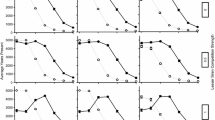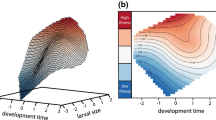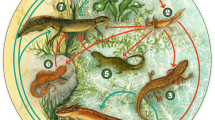Abstract
Although variation within populations in plasticity to time constraints is expected with regard to hatching date, empirical studies are largely lacking. We studied life-history responses to time constraints manipulated by photoperiod and associated with hatching date in larvae of the damselfly Lestes viridis for two populations with a different hydroperiod. In a common garden experiment, early- and late-hatched larvae from both populations were reared at two photoperiods mimicking the start and the end of the egg-hatching season. In a reciprocal transplant experiment, early- and late-hatched larvae from both populations were reared in both ponds. In all these experiments, larvae were reared from egg hatching until adult emergence. Within both populations, larvae reared at the photoperiod indicating a late time point in the growing season, reduced development time to compensate for their perceived shorter development period. Growth rate, however, did not respond to photoperiod, resulting in a lower mass at emergence. As expected, both in the laboratory and in the field, larvae from eggs that hatched later in the season generally had a shorter development time and a faster growth rate, resulting in a higher mass at emergence compared to early-hatched larvae. This may explain the intriguing seasonal increase in mass at emergence in this species, and affect the predictions of optimality models. None of these life-history responses differed between the two populations, despite clear differences in time constraints linked to hydroperiod, suggesting the robustness of the observed patterns. Given the ubiquity of asynchronous hatching in nature, and the adaptive value of the observed differences between early- and late-hatched larvae, we expect the effects of hatching date on life-history plasticity to be widespread.


Similar content being viewed by others
References
Abrams PA, Leimar O, Nylin S, Wiklund C (1996) The effect of flexible growth rates on optimal sizes and development times in a seasonal environment. Am Nat 147:381–395
Abrams PA, Rowe L (1996) The effects of predation on the age and size of maturity of prey. Evolution 50:1052–1061
Altwegg R (2002) Predator-induced life-history plasticity under time constraints in pool frogs. Ecology 83:2542–2551
Carrière Y, Simons AM, Roff DA (1996) The effect of the timing of post-diapause egg development on survival, growth, and body size in Gryllus pennsylvanicus. Oikos 75:463–470
De Block M, Stoks R (2003) Adaptive sex-specific life history plasticity in a damselfly. J Evol Biol 16:986–995
De Block M, Stoks R (2004) Cannibalism-mediated life history plasticity to combined time and food stress. Oikos (in press)
Gurney WSC, Jones W, Veitch AR, Nisbet RM (2003) Resource allocation, hyperphagia, and compensatory growth in juveniles. Ecology 84:2777–2787
Jödicke R (1997) Die Binsenjungfern und Winterlibellen Europas. Westarp, Magdeburg
Johansson F, Rowe L (1999) Life history and behavioral responses to time constraints in a damselfly. Ecology 80:1242–1252
Johansson F, Stoks R, Rowe L, De Block M (2001) Life history plasticity in a damselfly: effects of combined time and biotic constraints. Ecology 82:1857–1869
Ludwig D, Rowe L (1990) Life-history strategies for energy gain and predator avoidance under time constraints. Am Nat 135:686–707
McPeek MA (1998) The consequences of changing the top predator in a food web: a comparative experimental approach. Ecol Monogr 68:1–23
Nylin S, Gotthard K, Wiklund C (1996) Reaction norms and size at maturity in Lasiommata butterflies: predictions and tests. Evolution 50:1351–1358
Roff DA (1992) The evolution of life histories: theory and analysis. Chapman and Hall, New York
Roff DA (2002) Life history evolution. Sinauer Associates, Inc., Sunderland
Rowe L, Ludwig D (1991) Size and timing of metamorphosis in complex life cycles: time constraints and variation. Ecology 72:413–427
SAS Institute (2000) SAS/STAT user’s guide, Version 8. SAS Institute Inc., Cary
Stearns SC (1992) The evolution of life histories. Oxford University Press, Oxford
Travis J (1994) Ecological genetics of life-history traits: variation and its evolutionary significance. In: Real LA (ed) Ecological genetics. Princeton University Press, New Jersey, pp 172–204
Verbeke G, Molenberghs G (1997) Linear mixed models in practice: a SAS oriented approach. Springer, Berlin Heidelberg New York
Via S, Gomulkiewicz R, De Jong G, Scheiner SM, Schlichting CD, Van Tienderen PH (1995) Adaptive phenotypic plasticity: consensus and controversy. Trends Ecol Evol 10:212–217
Wellborn GA, Skelly DK, Werner EE (1996) Mechanisms creating community structure across a freshwater habitat gradient. Annu Rev Ecol Syst 27:337–363
Acknowledgements
We thank Thierry Backeljau, Dirk Bauwens, Steven De Clerck, Frank Johansson and two anonymous referees for comments on the manuscript. M.D.B. is funded by a grant from the Flemish Institute for the Promotion of Innovation by Science and Technology (IWT) and R.S. is a postdoctoral fellow of the Fund for Scientific Research Flanders (FWO). This study was supported by an FWO research grant to R.S.
Author information
Authors and Affiliations
Corresponding author
Rights and permissions
About this article
Cite this article
De Block, M., Stoks, R. Life-history variation in relation to time constraints in a damselfly. Oecologia 140, 68–75 (2004). https://doi.org/10.1007/s00442-004-1575-6
Received:
Accepted:
Published:
Issue Date:
DOI: https://doi.org/10.1007/s00442-004-1575-6




